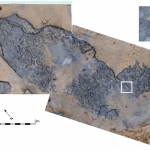Human Footprints Discovered on England’s Coast Are Oldest Outside Africa

Archaeologists working on the eastern coast of England have found a series of footprints that were made by human ancestors sometime between 780,000 and one million years ago. Pressed into ancient estuary mudflats now hard with age, these prints are the oldest ones known outside of Africa, where humanity got its start.
Scientists discovered the prints early last May at the seaside site of Happisburgh in Norfolk. High seas had eroded the beach sand to reveal the ancient mudflats beneath. The team had to act quickly to record the footprint surface before it, too, eroded. They used a technique called multi-image photogrammetry and laser scanning to capture the footprints in three dimensions. By the end of May the prints were gone, thanks to the unrelenting surf.
In a paper published today by PLOS ONE, Nick Ashton of the British Museum and his colleagues report that analysis of the footprints—which show impressions of the arch, ball, heel and toes of several individuals—suggests they were left by a party of five as they walked south along a large river. Based on the apparent foot lengths, members of the group ranged in height from 0.93 meter to 1.73 meters, evidence that the group was composed of both adults and youngsters. The researchers estimate the body mass of the adults at 48 to 53 kilograms.
Exactly which species of early human made the footprints is unknown, because no human remains have turned up at the site. But judging from the antiquity of the prints, a likely candidate is Homo antecessor, a species that is known from the site of Atapuerca in Spain and that had body dimensions similar to those reconstructed for the largest Happisburgh footprint makers.
Happisburgh is the oldest known site of human occupation in northern Europe. Previous excavations there have turned up dozens of flint tools that those ancient peoples may have used to butcher animals or process their skins. They lived alongside a menagerie of large mammals, including mammoths, rhinos, horses and bison.
There’s just something about ancient footprints that makes the heart beat faster. I suppose it’s the combination of seeing a moment in time captured so vividly and being left to wonder what came before and after that moment. Where had these ancient people come from? Where were they going? And why? Were they foraging for food? Looking for raw materials to make tools? Or were they simply out for a Sunday stroll? We won’t ever know for sure. But perhaps continuing erosion of the coastline at Happisburgh will reveal more clues to the lives they lived.
About the Author: Kate Wong is an editor and writer at Scientific American covering paleontology, archaeology and life sciences. Follow on Twitter @katewong.
